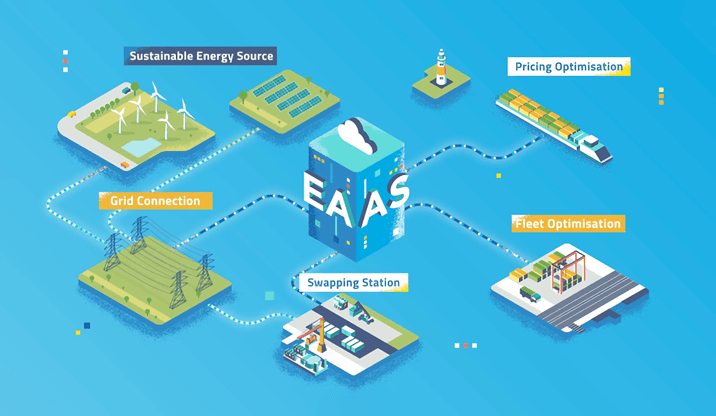Shipping’s multi-fuel future will require entirely new thinking on how to replace today’s carbon-heavy maritime operations with smart digital energy systems.
LR is providing assurance support for a European Commission funded project – within the Horizon 2020- program, Current Direct, that is set to transform not only shipping’s energy sources, but also some of the sector’s energy procurement business models.
Current Direct is one of a series of industry-driven initiatives assessing ways in which shipping’s long-established fuel procurement process can support its decarbonisation drive. This project is right at the forefront of moves to adapt the sector to its inevitable multi-fuel future. It is researching the transformation that will be required for the adoption of smart, digital energy supply systems based on entirely new business models.
The project is not only demonstrating the possible future use of swappable battery energy storage systems – and how they shape up in a shipping context – but it will inform the sustainability, safety, and security of both the fuels themselves and shipping’s energy supply chain. Fuels of the future may have been identified already, but the new thinking that underpins the Current Direct initiative has far-reaching broader implications for power procurement in many shipping sectors.
Duncan Duffy is Global Head of Technology, Electro Technical Systems, at LR. He and a wider team of LR experts led by Paolo Scialla are working closely with the diverse range of Current Direct partners. They include Aviloo, Blackstone Resources, EDP CNET, Foreship, Kotug, rhoé, Spear Power Systems, Umicore, Uhasselt, Vito, Vrije Universiseit Brussel, and Wärtsilä.
Battery technology is central to the Current Direct project, which aims to electrify the energy systems required for the movement of people and goods by water. Its main focus is the development of electrical energy – specifically, swappable batteries – and a revolutionary ‘Energy as a Service’ Platform that will unlock new and innovative business models.

Initially, the project will put containerised batteries and the business framework to the test in the Port of Rotterdam. The medium-term aim, however, is to roll out the setup – both the technology and the new energy procurement process – to consumers of shipping services on inland waterways, coastal shipping routes, ferry crossings, and ultimately, maybe even on deep-sea routes.
Battery brainwaves
One of the Current Direct partners is Ryan Kostos, an enthusiastic systems engineer with lots of bright ideas about batteries. Kostos works for Spear Power Systems, a Kansas City-based energy storage specialist with industry leading experience in the marine, industrial, aerospace, and defence markets. Based in Brussels, Kostos is focused on building the battery technology and support systems that will ensure success for Current Direct.
In a recent interview, Duffy explained how the Current Direct project could set a new framework for swappable power supplies on board ships. Meanwhile, Kostos shared that the project aims to drastically reduce cost and increase energy through a range of innovations along with the development of an Energy as a Service business model for reducing the barrier to electrify and facilitate commercialisation. The maritime industry is an attractive market for the commercialisation of Current Direct, he said, because it opens a high-value proposition with great scope for energy storage systems.
The Brussels hub is an important aspect of Spear’s progressive strategy. The company plans to establish global manufacturing and supply chains. Knowing that shipping is a global business – not only over the ocean, but on inland waterways all over the world – the company is intent on having more than just a foot in the door of pioneering projects like Current Direct and, of course, pursuing the outcomes.
Pioneering technology
One of the ways the Current Direct project is doing this is to focus on technological advances in battery design and operation. Battery energy storage systems provide immediate power, allowing them to fully support vessel operations or work with alternate fuels, such as hydrogen or LNG, which offer poor response to demand fluctuations. To accelerate the adoption of new energy sources the volumetric and gravimetric energy densities of today’s battery systems needs to increase. This is being realized through innovations at the both the pack and cell level along with an optimized integration of the battery system into a standardized container format.
This, Kostos explained, is a prime consideration in swappable battery packs for vessels as increased volumetric and gravimetric energy density is particularly important for mobile applications. Not only must they provide sufficient performance for a ship in operation, but they must also be in a standardised offering that don’t take up much space and can be easily swapped.
There are dramatic developments under way, some of which will be made easier and cheaper by new additive manufacturing technology, or 3D printing, as it is often known. Kostos highlighted that the battery’s electrode which, with current technology, is built using a slurry coating process.
Latest research, however, using novel 3D printing technology is achieving 20% thicker electrodes when compared to conventional manufacturing techniques. This approach enables higher energy, flexibility, and reduced cost.
Additional savings from 3D printing could well mean that the entire production process could be 60-70% less energy intensive. This, combined with labour and space savings, has been estimated to yield significant savings in production costs.
Safer, smaller, stronger…
LR’s Duffy noted that from an assurance point of view, these developments are attractive, if challenging. “Our aim, within Current Direct, is to develop safety certification approaches that suit the concept so that these can be proposed to the maritime industry with appropriate justifications.”
The 3D printing cell manufacturing process can be readily adapted to accommodate future battery technologies as they are commercialised. By way of example, Duffy referred to solid-state electrolytes are that are being researched elsewhere. These are inherently safer than liquid electrolytes because there is a reduced risk of short circuits developing between electrodes. Cells based on that technology, combined with careful design of module assembly and type testing, can significantly reduce the risk of thermal runaway occurring in lithium battery systems.
And tomorrow’s batteries will be smaller, more powerful, and faster to charge, he noted, potentially opening up a wider range of applications. The Current Direct partners are aiming to triple the energy available in a conventional 20-foot battery container from one megawatt hour to three. So two of these battery packs would provide up to six hours of energy for an inland waterway craft consuming 1,000 kilowatts per hour.
Sustainability is another issue, Duffy emphasised. Lower density electrode structures could well use less of the world’s rare metals than existing ones – a key consideration as the world’s energy systems adopt energy storage as a system component.
What really appeals, however, is the potential for what Duffy describes as improved battery lifecycle ‘route optimisation’ which hopes to transform the safety and security of battery packs with through-life, real-time condition monitoring. This digital capability is now possible by using ‘single cell supervisors’ within the cell that can track battery condition and communicate directly with the master board through the existing power bus. On inland waterways, coastal routes, and workboats in rivers and harbours, both Duffy and Kostos believe that swappable energy packs have the potential to transform operations.
The digital monitoring capability would mean that service corridors could be established to provide charged containers where they are needed. Access to the battery pack containers would no longer be necessary, making more space for energy storage, while crew would receive information on the status and available supply of ships’ power but would not be required to carry out maintenance.
They would, of course, still oversee the integrity of shipboard battery connections but the condition of the batteries themselves would be managed remotely as part of ‘Energy as a Service’. Meanwhile, the condition of batteries requiring attention or replacement would be evident to remote engineers capable of ensuring that ships’ energy systems remains dependable at all times.
Ultimately, this quantum leap in battery technology could result in a range of power sources on board a ship in which swappable batteries could provide a core component. Through a power grid, renewable energies from fuel cells, wind, sun, and shore power, for example – could feed into a hybrid electrical power system to cover energy requirements for cargo handling, hotel loads, and the peaks and troughs of varying propulsion loads in routine operations. Current Direct aims to tackle this challenge through innovations at all levels while building a novel Energy as a Service ecosystem to accommodate today’s and tomorrow’s technologies to facilitate electrification.
Duffy was keen to highlight the scale of the assurance challenge when essential services are not a permanent part of the ship. The end result could well be transformational, he concluded, but safety, sustainability and security will remain the top priorities for LR in its Current Direct project participation and beyond.
For more information, please contact info@currentdirect.eu or visit www.currentdirect.eu







